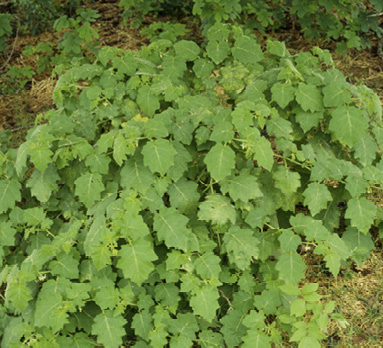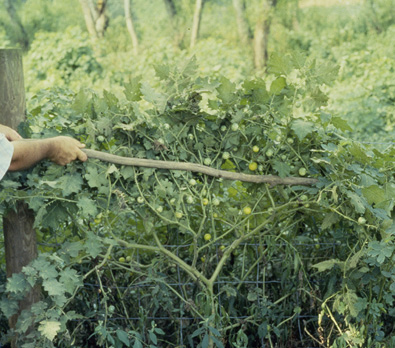Tropical Soda Apple
Tropical soda apple, Solanum viarum Dunal, is a perennial shrub (Figure 1). It is native to Brazil and Argentina, but it has become a weed in other areas of South America and in Africa, India, Nepal, the West Indies, Honduras, Mexico, and the United States. It has been reported that tropical soda apple foliage is unpalatable to livestock, although cattle will eat the mature fruit. Scarification of seeds by digestive systems of livestock and wildlife seems to promote germination. Movement of livestock that have recently consumed tropical soda apple is the primary cause for long-distance spread. However, contaminated equipment, hay, seeds, composted manure, and sod may also disperse the weed. Once established in an area, wildlife may continue the short-range spread of tropical soda apple.



Tropical soda apple is an alternate host for diseases of eggplant, peppers, potatoes, and tomatoes. Tropical soda apple cost the cattle business over $11 million in 1994. Damage to croplands, forestlands, and natural habitats and the cost of control of currently infested areas is difficult to determine, but tropical soda apple has the potential to become a major problem throughout the U.S. south.
To detect and prevent further spread of this weed in the U.S., extension services, departments of agriculture in several southern states, and the U.S. Department of Agriculture have initiated an education and notification campaign on the potential problem of the tropical soda apple. Early detection and persistent monitoring of populations is paramount to containing the threat of this weed, which can potentially infest millions of acres of pastures, crops, forests, and natural areas in the country.
Tropical soda apple is a noxious weed in the U.S; it is a state noxious weed in Florida, Mississippi, and Texas. Cattle from areas infested with tropical soda apple plants must be quarantined before moving into several states.
Description
Vegetative Growth
Mature tropical soda apple plants are 3 to 6 feet tall and can be as wide. Plants are armed on the leaves, stems, pedicles, petioles, and calyxes with broad-based, white to yellowish, thorn-like prickles up to 3/4 inch long (Figure 2). The leaves and stems are downy. Stems are green. Tropical soda apple is closely related to Carolina horsenettle (Solanum carolinense L.), which rarely exceeds 3 feet tall and can have green or purple stems.
Flowering and Fruit
Not to be confused with Carolina horsenettle, tropical soda apple flowers are white with five petals that curve backward and white-cream stamens that surround the single pistil. Carolina horsenettle flower petals are not curved backward and can be either white or purple.
Immature fruits are mottled whitish to light green and dark green, like a watermelon (Figure 2). Mature fruits are smooth, round, and 3/4 to 1-1/4 inches in diameter with a leathery, yellow skin surrounding a thin-layered, pale green, scented pulp and 180 to 420 flattened, reddish-brown seeds (Figure 3). Each plant is capable of producing 200 or more fruit per year. In comparison, Carolina horsenettle fruits are glossy-green (immature), turn yellow at maturity, are 1/2 to 3/4 inch in diameter, and typically occur in clusters.
Habitat
Since its introduction into the U.S., tropical soda apple has spread rapidly, infesting an estimated one million acres of improved pastures, citrus groves, sugar cane fields, ditches, vegetable crops, sod farms, forestlands (oak hammocks and cypress heads), and other natural areas in Alabama, Florida, Georgia, and Mississippi. Although it is a threat to a variety of habitats, it tends to be most problematic in pastures and surrounding woodlands in the Midsouth.
Distribution
The primary means of dispersal of tropical soda apple in the U.S. is livestock and wildlife, such as raccoons, deer, feral hogs, and birds. The first known collection of tropical soda apple in the U.S. was from Glades County, Florida, in 1988. Because of its rapid population explosion in Florida and the concerns of livestock producers, tropical soda apple was placed on the Florida noxious weed list in late February 1994 and was placed on the federal noxious list in 1995. It has currently escaped from North Carolina to Tennessee and Louisiana in the southeast and Pennsylvania in the northeast. Tropical soda apple occurs in most of Florida’s counties. It was found in Mississippi in October 1993. It has been confirmed at 20 sites in 10 Mississippi counties. It has been reported in all Midsouth states except Arkansas.
Control Methods
Chemical
Aminopyralid, triclopyr, and hexazinone are effective for controlling emerged tropical soda apple when applied at recommended rates (Table 1). If plants have been established long enough to release seed, the site should be frequently inspected and newly emerged seedlings treated. Aminopyralid and hexazinone have longer residual than triclopyr.
|
Chemical |
Trade name |
Rate per acre |
|
Aminopyralid |
Milestone |
7 fl oz |
|
Aminopyralid + 2,4-D |
Grazon Next |
42 fl oz |
|
Aminpyralid + metsulfuron |
Chaparral, Opensight |
2.5–3 oz |
|
Aminopyralid + triclopyr |
Milestone VM |
7 fl oz |
|
Hexazinone (2 lb ai/gallon) |
Hexar, Velpar, Velossa, etc. |
64 fl oz |
|
Triclopyr (4 lb ae/gallon) |
Garlon, Remedy, Triclopyr, Trycera, etc. |
32 fl oz |
|
Triclopyr (3 lb ae/gallon) |
Garlon 3A, Element, Renovate, Tahoe, Tailspin, etc. |
43 fl oz |
|
Triclopyr + fluroxypyr |
PastureGard |
48 fl oz |
Mechanical and Cultural
Since plants have thorns, use caution if removing by hand. Plants can regenerate from roots, so complete removal is necessary. To prevent tropical soda apple spread within a farm or community, take steps to minimize seed production. Mowing is an effective practice to prevent seed production, even after flowering has started, although plant regrowth will occur, and the practice must be repeated when plants start flowering again. Plants with mature fruit should be cut, piled, and burned to destroy seed viability, or buried more than 3 feet deep.
The only cultural control is sanitation. Collect fruit prior to maturity and dispose of by burning or cooking. Quarantine livestock at least 7 days in an area with no tropical soda apple before moving to new, uninfested locations.
References
Mullahey, J. J., Cornell, J. A., & Colvin, D. L. (1993). Tropical soda apple (Solanum viarum) control. Weed Technology, 7, 723-727.
Mullahey, J. J., Nee, M., Wunderlin, R. P., & Delaney, K. R. (1993). Tropical soda apple (Solanum viarum): A weed threat to subtropical regions. Weed Technology, 7, 783-786.
Publication 3200 (POD-03-24)
By John Byrd Jr., PhD, Extension/Research Professor, Plant and Soil Sciences; Victor Maddox, PhD, Senior Research Associate, Plant and Soil Sciences; Charles T. Bryson, Research Botanist, USDA Crop Production Research Unit, Stoneville, MS; and Randy Westbrooks, PhD, former Invasive Species Specialist, U.S. Geological Survey.
The Mississippi State University Extension Service is working to ensure all web content is accessible to all users. If you need assistance accessing any of our content, please email the webteam or call 662-325-2262.


